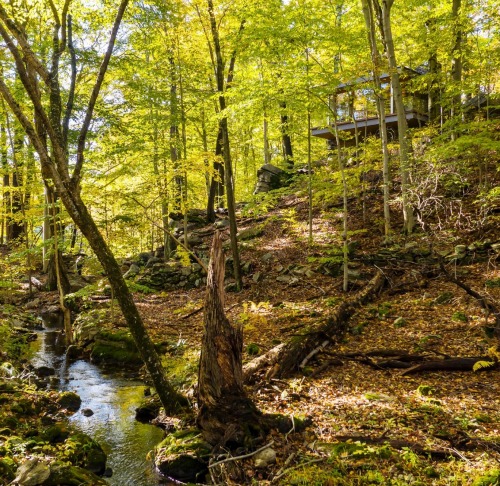Passkale - Untitled

More Posts from Passkale and Others










Writer’s S T U D I O
in the woods of Greenwich, inspired by Thoreau,
minimalist haven with 1500 books
© Eric J. Smith Architect


(via Former US Secretary of Defense William Perry in an interview with Radio Sputnik)

Step into one of the nation’s top art museums, and most of the works you’ll see were made by men.
The Baltimore Museum of Art has decided to make a bold step to correct that imbalance: next year, the museum will only purchase works made by female-identifying artists.
“This how you raise awareness and shift the identity of an institution,” museum director Christopher Bedford told The Baltimore Sun. “You don’t just purchase one painting by a female artist of color and hang it on the wall next to a painting by Mark Rothko. To rectify centuries of imbalance, you have to do something radical.”
The policy will only apply to works purchased by the museum, not gifts. The number of works purchased by the museum each year varies, and works are bought on a rolling basis.
The move is part of a larger initiative launched in October called 2020 Vision, a series of 22 exhibits at the museum celebrating female-identifying artists. The initiative includes 13 solo exhibitions and seven thematic shows, with more being planned. Next year marks a century since women were guaranteed the right to vote in the United States, with the ratification of the 19th Amendment.
The Baltimore Museum of Art has 95,000 works, including the world’s largest collection of works by Henri Matisse.
Its collections include 3,800 works by women artists and designers – just 4% of its holdings.
Baltimore Museum Of Art Will Only Buy Works By Women Next Year
Image: The Baltimore Museum of Art Caption: The Baltimore Museum of Art will only buy works by women next year, as part of a yearlong series exhibiting art by women. Amy Sherald’s Planes, rockets, and the spaces in between (2018) is among the 3,800 works by women in the museum’s collection
What's a Question you wish someone would ask?
21 Years of Amazing Earth Imagery
On April 29, 1999, NASA Earth Observatory started delivering science stories and imagery to the public through the Internet. Today, we turn 21! So much has changed in the past two decades…
One of the most notable changes is the way we view our home planet. Check out some of the beautiful imagery of our planet over the past 21 years.
2000: Pine Island Glacier

Most people will never see Pine Island Glacier in person. Located near the base of the Antarctic Peninsula—the “thumb” of the continent—the glacier lies more than 2,600 kilometers (1,600 miles) from the tip of South America. That’s shorter than a cross-country flight from New York to Los Angeles, but there are no runways on the glacier and no infrastructure. Only a handful of scientists have ever set foot on its ice.
This animation shows a wide view of Pine Island Glacier and the long-term retreat of its ice front. Images were acquired by the Moderate Resolution Imaging Spectroradiometer (MODIS) on our Terra satellite from 2000 to 2019. Notice that there are times when the front appears to stay in the same place or even advance, though the overall trend is toward retreat. Read more.
2002: The Blue Marble

In February 2002, Earth Observatory published this “blue marble” image based on the most detailed collection of true-color imagery of the entire Earth at that time. Using a collection of satellite-based observations, scientists and visualizers stitched together months of observations of the land surface, oceans, sea ice and clouds into a seamless, true-color mosaic of every square kilometer (.386 square mile) of our planet. Most of the information contained in this image came from Moderate Resolution Imaging Spectrometer (MODIS), illustrating the instrument’s outstanding capacity to act as an integrated tool for observing a variety of terrestrial, oceanic and atmospheric features of the Earth. Read more.
2009: Tsauchab River Bed

The Tsauchab River is a famous landmark for the people of Namibia and tourists. Yet few people have ever seen the river flowing with water. In December 2009, an astronaut on the International Space Station caught this glimpse of the Tsauchab River bed jutting into the sea of red dunes. It ends in a series of light-colored, silty mud holes on the dry lake floor.
Like several other rivers around the Namib Desert, the Tsauchab brings sediment down from the hinterland toward the coastal lowland. This sediment is then blown from the river beds, and over tens of millions of years it has accumulated as the red dunes of the Namib Sand Sea. Read more.
2012: Manning Island and Foxe Basin, Canada

Although it may look like a microscope’s view of a thin slice of mineral-speckled rock, this image was actually acquired in space by the Earth Observing-1 satellite in July 2012. It shows a small set of islands and a rich mixture of ice in Foxe Basin, the shallow northern reaches of Hudson Bay.
The small and diverse sizes of the ice floes indicate that they were melting. The darkest colors in the image are open water. Snow-free ice appears gray, while snow-covered ice appears white. The small, dark features on many of the floes are likely melt ponds. Read more.
2013: A Lava Lamp Look at the Atlantic

Stretching from tropical Florida to the doorstep of Europe, this river of water carries a lot of heat, salt, and history. The Gulf Stream is an important part of the global ocean conveyor belt that moves water and heat across the North Atlantic from the equator toward the poles. It is one of the strongest currents on Earth, and one of the most studied.
This image shows a small portion of the Gulf Stream as it appears in infrared imagery. Data for this image was acquired on April 9, 2013, by the Thermal Infrared Sensor (TIRS) on the Landsat 8 satellite. TIRS observes in wavelengths of 10.9 micrometers and 12.0 micrometers. The image above is centered at 33.06° North latitude, 73.86° West longitude, about 500 kilometers (300 miles) east of Charleston, South Carolina. Read more.
2016: Curious Ensemble of Wonderful Features

When John Wesley Powell explored the Colorado River in 1869, he made the first thorough survey of one of the last blank spots on the map. The expedition began in May at Green River, Wyoming, and ended three months later at the confluence of the Colorado and Virgin Rivers in present-day Nevada.
About two months into their journey, the nine men of the expedition found themselves in Glen Canyon. As the men traveled along the serpentine river channel, they encountered what Powell later described in Canyons of Colorado as a “curious ensemble of wonderful features.”
From above, the view of Glen Canyon is equally arresting. In 2016, an astronaut aboard the International Space Station took several photographs that were combined to make a long mosaic. The water has an unnatural shade of blue because of sunglint, an optical phenomenon that occurs when sunlight reflects off the surface of water at the same angle that a camera views it. Click here to see the long mosaic.
2019: Lena Delta Shakes Off Water

For most of the year, the Lena River Delta—a vast wetland fanning out from northeast Siberia into the Arctic Ocean—is either frozen over and barren or thawed out and lush. Only briefly will you see it like this.
After seven months encased in snow and ice, the delta emerges for the short Arctic summer. The transition happens fast. The animation above, composed of images from the Moderate Resolution Imaging Spectroradiometer (MODIS) on our Aqua satellite, shows the transformation from June 3-10, 2019. Read more.
2020: Making Waves in the Andaman Sea

When tides, currents and gravity move water masses over seafloor features, they can create wave actions within the ocean. Oceanographers began studying these internal waves from ships in the 1960s, and the modern era of satellites has made it possible to see them on a grand scale. The Operational Land Imager (OLI) on Landsat 8 captured these images of the Andaman Sea on November 29, 2019. The reflection of the Sun on the ocean—sunglint—helps make the internal waves visible.
Internal waves form because the ocean is layered. Deep water tends to be colder, denser and saltier, while shallower water is often warmer, lighter and fresher. The differences in density and salinity cause layers of the ocean to behave like different fluids. When tides, currents, gravity and Earth’s rotation move these different water masses over seafloor formations (such as ridges or canyons), they create waves within the sea. Read more.
These images were taken from NASA Earth Observatory!
Interested in receiving Earth Observatory’s Images of the Day? Subscribe to our newsletters or RSS feeds.
Make sure to follow us on Tumblr for your regular dose of space: http://nasa.tumblr.com.
Two new Peterson guides for spring birding
Spring is finally here, so we’re looking for more and more excuses to get outside. One of our favorite ways to experience the outdoors is to go birding. Luckily, there are two new Peterson guides to help you identify birds through song and sight, when you’re hiking or enjoying the great outdoors.

Peterson Field Guide to Bird Sounds of Western North America
This is a comprehensive field guide that uses an innovative Sound Index to teach readers how to quickly identify unfamiliar songs and bird calls in western North America. Read an excerpt.
Learn more and purchase your copy

Peterson Reference Guide to Sparrows of North America
Sparrows are as complicated as they are common. This is an essential guide to to identifying 76 varieties, as well as fascinating history of human interactions with them. Read an excerpt.
Learn more and purchase your copy
Get updates on the latest Peterson releases and exclusive nature news by signing up for our newsletter


And that’s a wrap! Thank you for all the great questions. We hope you learned a little bit about what it takes to work in mission control as a flight director.
If you’re hungry for more, you can read the latest installment of our First Woman graphic novel series, where fictional character Commander Callie Rodriguez embarks on the next phase of her trailblazing journey and leaves the Moon to take the helm at Mission Control.
Keep up with the flight directors, the Space Station, and the Artemis missions at the links below.
Flight directors: X
Artemis: Facebook: Facebook, Instagram, X
Space Station: Facebook, Instagram, X (@Space_Station), X( @ISS_Research)
Make sure to follow us on Tumblr for your regular dose of space!
